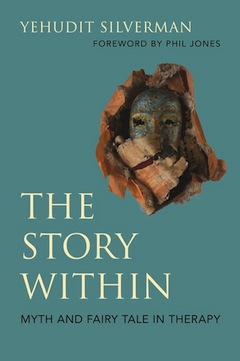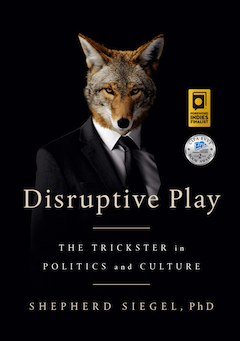A participant in Yehudit Silverman’s The Story Within process shows off their self-made mask. (photo from Yehudit Silverman)
This past spring, Prof. Yehudit Silverman’s new book came out. In The Story Within: Myth and Fairy Tale in Therapy, the Concordia University professor emerita walks people through a step-by-step process to healing.
“When a person embarks on this journey, they feel called to a story, but they don’t know why,” said Silverman. “And it’s the sense of the unknown that’s really important…. Sometimes, in conventional therapy, we just go around in circles and might not necessarily get to the deeper layers that are inaccessible to us. But, through the arts and through the use of a character from a myth or fairy tale, gradually we can access those areas in ourselves.”
In Silverman’s approach, clients start by choosing their own story after going through a couple of exercises. “That process of choosing the story is therapeutic and healing in itself, because it’s part of the person’s sense of their own sense of knowing their own strengths and their own intuition, which is really important,” she explained. “Also, it’s important to stay with one character in a story for a long time, allowing the depth work to be done … recognizing what the character’s quest is, which is so important in myth and fairy tale, which is why I think they are still so relevant.
“The protagonist is on a quest and has to face obstacles and challenges,” she continued. “That can be so helpful when people are facing their own challenges and obstacles, so they don’t feel so alone. Also, they get to work with fiction, which is very safe, providing a certain amount of distance.”
People choose their stories for different reasons.
“Someone might be really drawn to a character that is having to do an impossible task, like in Rumpelstiltskin, where the girl has to make straw into gold,” said Silverman. “A lot of people think they are facing an impossible task, so they might then choose that story.
“Sometimes, it’s just the title of the story. I worked with an adolescent who was homeless and, sadly, addicted to drugs. When I worked with her, she chose the story of the handless maiden, which led to, sadly, to the revelation of her having been abused as a child. It was just the title that drew her.”
Once people choose a character, they start to build a mask. Then, they build the environment for the character and go through the steps that are described in Silverman’s book. The process is usually done within the context of a group, so that it is witnessed, which, according to Silverman, aids significantly in healing.
“They work with other people so that, at some point, they actually direct someone else in their mask and in their costume,” she said. “They get to look at what their character looks like to an outsider. And then, they have people embodying the obstacle and the helper, so they actually embody going through the quest and the challenges of the character.”
Silverman once worked with an anorexic teen who chose the character of Dorothy from The Wizard of Oz. “For her, the tornado was her eating disorder that took her to the Wonderful Land of Oz … which was, for her, magical. It was the ‘Land of Starvation’ and the good witch, Glenda, was actually evil for her, because she was trying to get her to go back to Kansas…. I realized that, for her, everyone in the hospital was evil, was going against what she felt was her sense of reality and her sense of what was magical and important, which was her starvation.
“And so, little by little, she worked with it and she embodied the tornado,” said Silverman. “She was actually swirling around and started crying, and realized how destructive it was. It was the first time she had had that realization – she didn’t have it when people were just talking to her.”
The teen connected and embodied the “chaotic energy of the tornado,” said Silverman. “She began to realize it was destructive and, then, she very slowly started healing. But, for her, having that story was essential.”
Although COVID-19 has made holding in-person group sessions impossible for Silverman, it has opened the door to including people from all over the world in the online groups she leads.
 The Story Within outlines Silverman’s process step-by-step, taking readers through each one, and it can be useful for both therapists looking to implement the technique, as well as anyone wanting to understand why they do what they do.
The Story Within outlines Silverman’s process step-by-step, taking readers through each one, and it can be useful for both therapists looking to implement the technique, as well as anyone wanting to understand why they do what they do.
“If you’re going through something that is severe or you are in crisis, you should definitely see a therapist,” said Silverman. “And, if you’re going to use the book, you should only use it in context of therapy. But, for people looking for personal healing and a way to have creative reflection about what their life and quest is, then it is definitely for those people – for seekers, for artists and, also, for therapists, as something to integrate into their process with clients. And that’s something I do a lot of right now – supervising therapists insofar as how to integrate this into their work.”
Silverman said already established groups can use the book, as well, to form a more solid structural foundation perhaps. And, “there are so many people at home right now, and they are really questioning what their life is about,” she added. With the anxiety, she said, “having this structure, where they can go through a creative process … is so life-giving. It really allows us to express what’s going on inside into an outside form.”
Rebeca Kuropatwa is a Winnipeg freelance writer.



